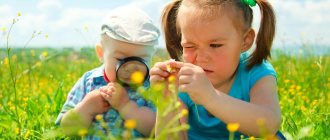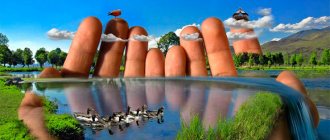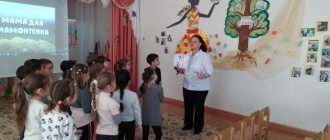Presentation on the topic “Forms and methods of environmental education of preschool children” presentation
Slide 1
FORMS AND METHODS OF ECOLOGICAL EDUCATION FOR PRESCHOOL CHILDREN
Slide 3
Observation Among the various methods of environmental education of preschoolers, an important place should be given to observation. Its essence lies in the sensory knowledge of natural objects, in their knowledge through various forms of perception - visual, auditory, tactile, gustatory, olfactory. The seasonal life of plants provides great opportunities for observation. The different conditions of trees and shrubs, the appearance and disappearance of herbaceous vegetation in the warm and cold seasons allow children, in the process of observation, to form ideas about the dependence of plant life on external conditions.
Slide 4
Requirements for conducting observations: 1. Any natural object should be as accessible as possible for perception. The child must see the object himself and everything that happens to it, hear the sounds emanating from it, be able to smell it, and hold it in his hands, if possible. 2. Temporal parameter of observation: examination and perception of any objects and natural phenomena should be short-lived. 3-10 minutes is the optimal time for intensive mental activity of children, for concentrating attention and independently obtaining and assimilating information. Children should begin and complete observation in a positive emotional state, without fatigue. 3. The third requirement is related to the structure of observations. Each of them has a beginning, a main part and an end. The beginning of observation solves a rather difficult task - to gather children and concentrate their attention. In the second, main part, the teacher asks questions and listens to the answers. The end of the observation should be emotional so that the children are in a good mood after it. Then next time they will want to observe themselves, without any special techniques
Slide 5
An excursion is another very interesting form of conducting environmental studies. An excursion is a complex event; it is planned, thought about, and prepared in advance. During the excursion, the mental development of children is influenced by various educational activities: observations of natural phenomena, explanations from adults, word games, guessing riddles.
Slide 6
Work. Interesting and varied work is carried out in the flower garden, vegetable garden, and plot. Children observe plants, practice labor skills (watering plants, loosening, collecting seeds and harvests, etc.). This work has a great influence on the development of hard work, independence and mutual assistance. In senior and preparatory school groups, it is possible to organize site duties in the spring and summer or assign groups of children to a garden bed or flower bed. The teacher conducts work and observations in a corner of nature with children every day. The form of organization of activities is different (depending on age). Children, starting from the younger group, are involved in certain work assignments.
Slide 7
Another form of environmental work in kindergarten is environmental holidays and leisure activities. Ecological holidays can be dedicated to the seasons, harvests, birds, etc.
Slide 8
Didactic games occupy a special place in introducing nature. By solving problems posed in a didactic game, the child learns to isolate individual characteristics of objects and phenomena, compare them, group them, and classify them according to certain general characteristics. Children learn to reason, draw conclusions, generalizations, while their attention, memory, and voluntary perception are trained. . Reading works of fiction about nature, looking at books of encyclopedic content
Slide 10
Environmental education is the education of morality, spirituality, and intelligence. The formation of the ecological culture of the population, the beginning of its formation falls on the first seven to eight years of a child’s life. It is in preschool age that learning the basics of environmental knowledge is most productive, since the child perceives nature very emotionally. The influence of nature on a child is enormous: it greets the baby with a sea of sounds and smells, secrets and riddles, makes him stop, take a closer look, and think. The beauty of the surrounding world gives rise to a feeling of attachment to the place where you were born and live, and, ultimately, love for the Fatherland.
Presentation “Forms and methods of environmental education of preschool children in accordance with the Federal State Educational Standard”
Makhova
Presentation “Forms and methods of environmental education of preschool children in accordance with the Federal State Educational Standard”
Consultation for parents
«Environmental education of preschool children»
The word " ecology "
and its derivatives have become firmly established in our everyday vocabulary, but are understood in different ways.
There are many definitions in the scientific literature. The most common: ecology is the science of the relationships of living organisms with each other and with the environment.
Typically, environmental education is understood as fostering a love for nature . Indeed, this is an important component of the educational process , but often the methods by which such love is cultivated are very questionable. For example, for this purpose, houses contain wild animals or domestic animals without proper care, which get sick and even die in front of children. And children get used to not noticing their torment. Often during summer walks, parents offer to pick flowers, catch butterflies, dragonflies or other insects. Such activities become constant summer fun for the children. They tear off insects' wings, legs, or even trample their prey with their feet. Thus, such educational activities teach children not to love, but to destroy living things, and quite cruelly.
Very often, children learn poems about nature, the content of which contradicts environmentally correct behavior. Taking this into account, it is necessary to emphasize once again that one of the tasks of environmental education is to form in the child an idea of man not as a master, a conqueror of nature, but as a part of nature that depends on it. Strive to eradicate the consumerist attitude towards nature in children.
Currently, most preschoolers have formed a clear division of animals into “bad” ones.
and
“good”
,
“evil”
and
“good”
,
“harmful”
and
“useful”
.
This is facilitated by works of art and cartoons. In many of them, predators are portrayed as evil, bad. They want to eat “good”
hares and piglets.
In them, as a rule, hares defeat wolves and are left to live alone in the forest, without evil predators. Many children are convinced that a predatory animal is bad, nature does not need it, and that a beautiful forest is a forest without wolves (without predators)
.
From an environmental point of view, “bad” things in nature
and
“good”
,
“harmful”
and
“useful”
.
Each animal and plant perform their “work”
and play a certain role in nature. Meanwhile, many once common plants and animals have become rare, our forests, once rich in mushrooms and berries, have become scarce, fertile soil particles are destroyed, water and air are polluted.
We, adults, cannot feel uninvolved in the modern problems of our society. The adults who are responsible for environmental disasters were once children too. It’s a shame that we can’t help but admit: we didn’t raise them .
successfully engage in environmental education only when you know exactly what this means.
Environmental education of children is, first of all, the education of humanity , that is, kindness, a responsible attitude towards nature, and towards the people who live nearby, towards descendants who need to leave the Earth suitable for a full life. Environmental education should teach children to understand themselves and everything that happens around them. We need to teach children how to behave correctly in nature and among people.
Educational tasks are sometimes complicated by the fact that children often see adults violating the basic norms of communication with each other and nature. Probably in such cases it is necessary to say: although they are adults, they do not know that they cannot speak rudely, leave garbage in rest areas, throw garbage while walking, carve inscriptions on tree trunks, or offend homeless animals.
Remember the rules!
— When in nature, you should not pick plants for bouquets. Bouquets can be made from those plants grown by humans.
— You can collect medicinal plants only in places where there are a lot of them.
— In nature, especially in the forest, you need to try to walk along paths so that the plants do not die from trampling.
— It is necessary to protect not only rare plants, but also other, even the most common plants.
— You can’t go close to bird nests. Following your tracks, predators can find and destroy your nests. If you accidentally find yourself near the nest, do not touch it, leave immediately. Otherwise, the parent birds may completely leave the nest.
— If you have a dog, do not take it with you into the forest. She can easily catch flightless chicks and helpless baby animals.
- Do not catch and take home healthy bird chicks and young animals. In nature, adult animals will take care of them.
-DO NOT FORGET that plants provide shelter for animals. Protect the grass, bushes, trees, you help the animals, birds, insects that take refuge in their thickets.
THE WEALTH OF THE NATIVE LANDS IS IN MAN’S HANDS.
REMEMBER THIS!






